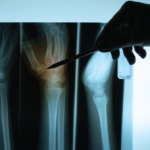NEW YORK (Reuters Health)—A body mass index (BMI) of less than 28 alone may be a tool to prescreen younger postmenopausal women for osteoporosis, according to a new study.
“For young postmenopausal white women aged 50–64, current prescreening modalities identifying candidates for DXA (dual-energy X-ray absorptiometry) scan … are not performing better than BMI alone,” Dr. Xuezhi (Daniel) Jiang from the Sidney Kimmel Medical College of Thomas Jefferson University in Reading, Pa., told Reuters Health by email.
“Although it is not our authors’ intention to suggest BMI alone as an alternative independent osteoporosis prescreening modality, BMI should be carefully considered while clinicians try to determine who should be referred for DXA scan. A better osteoporosis prescreening risk assessment tool remains to be developed,” he explained.
Dr. Jiang and colleagues compared the screening performance of BMI with five currently recommended modalities for advising DXA in postmenopausal women. The five modalities are:
- The U.S. Preventive Services Task Force (USPSTF) fracture risk assessment tool (FRAX) threshold of at least 9.3% for 10-year risk of major osteoporotic fracture;
- The Osteoporosis Self-Assessment Tool (OST) based on age and weight (weight in kg minus age in years) with a score of <2;
- The Simple Calculated Osteoporosis Risk Estimation (SCORE) that calculates a score based on age, race, rheumatoid arthritis (RA), nontraumatic fractures of the spine, hip, or wrist, prior estrogen therapy use and weight with a score of <-2;
- The Osteoporosis Risk Assessment Instrument (ORAI), which calculates a score based on age, weight and estrogen therapy use with a score of at least nine; and
- A risk-factor (RF) score based on women having one or more of the following: hip or spine fracture after age 50, parental hip fracture, ever or current long-term use of steroids, current smoking, small stature and medical history of RA.
The researchers recruited 445 postmenopausal women aged 50–64 presenting for DXA test based on the above scores between 2007–2009. They obtained results of each DXA for analysis and conducted a telephone survey to gather data on age, race, weight, height, osteoporosis risk factors, current smoking and other factors. The women had the DXA tests at one of four Jefferson radiology sites in the greater Hartford, Conn., area.
Most of the women (95%) were white, the average age was 57, and the mean BMI was 27. Thirty-eight (8.5%) had osteoporosis and three (0.7%) had an osteoporotic fracture. Of the 445 women, only one was underweight, 195 were normal weight, 132 were overweight and 117 were obese.
